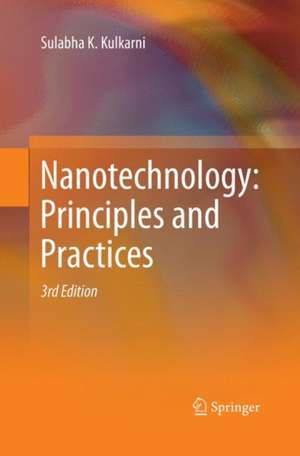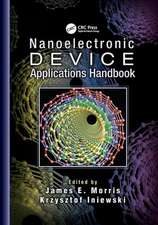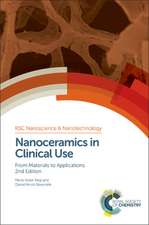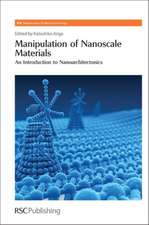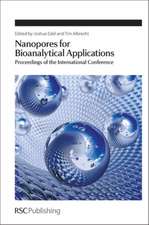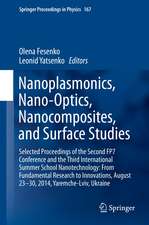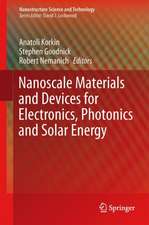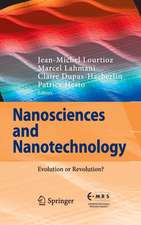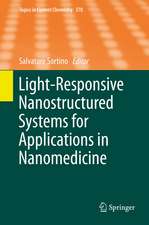Nanotechnology: Principles and Practices
Autor Sulabha K. Kulkarnien Limba Engleză Paperback – 27 mar 2019
The book goes on to illustrate the various applications of nanomaterials in electronics, optoelectronics, cosmetics, energy, textiles and the medical field and discusses the environmental impact of these technologies. Many new areas, materials and effects are then introduced, including spintronics, soft lithography, metamaterials, the lotus effect, the Gecko effect and graphene. The book also explains the functional principles of essential techniques, such as scanning tunneling microscopy (STM), atomic force microscopy (AFM), scanning near field optical microscopy (SNOM), Raman spectroscopy and photoelectron microscopy. In closing, Chapter 14, ‘Practicals’, provides a helpful guide to setting up and conducting inexpensive nanotechnology experiments in teaching laboratories.
| Toate formatele și edițiile | Preț | Express |
|---|---|---|
| Paperback (1) | 469.17 lei 38-44 zile | |
| Springer International Publishing – 27 mar 2019 | 469.17 lei 38-44 zile | |
| Hardback (1) | 596.69 lei 6-8 săpt. | |
| Springer International Publishing – 17 noi 2014 | 596.69 lei 6-8 săpt. |
Preț: 469.17 lei
Nou
Puncte Express: 704
Preț estimativ în valută:
89.80€ • 97.58$ • 75.48£
89.80€ • 97.58$ • 75.48£
Carte tipărită la comandă
Livrare economică 17-23 aprilie
Preluare comenzi: 021 569.72.76
Specificații
ISBN-13: 9783319791630
ISBN-10: 331979163X
Pagini: 403
Ilustrații: XXIV, 403 p. 341 illus., 13 illus. in color.
Dimensiuni: 155 x 235 mm
Ediția:Softcover reprint of the original 3rd ed. 2015
Editura: Springer International Publishing
Colecția Springer
Locul publicării:Cham, Switzerland
ISBN-10: 331979163X
Pagini: 403
Ilustrații: XXIV, 403 p. 341 illus., 13 illus. in color.
Dimensiuni: 155 x 235 mm
Ediția:Softcover reprint of the original 3rd ed. 2015
Editura: Springer International Publishing
Colecția Springer
Locul publicării:Cham, Switzerland
Cuprins
Introduction to Quantum Mechanics.- Chapter 1: Structure and Bonding.- Chapter 2: Synthesis of Nanomaterials—I (Physical Methods).- Chapter 3: Synthesis of Nanomaterials—II (Chemical Methods).- Chapter 4: Synthesis of Nanomaterials—III (Biological Methods).- Chapter 5: Self Assembly.- Chapter 6:Analysis Techniques.- Chapter 7: Types of Nanomaterials and Their Properties.- Chapter 8: Nanolithography.- Chapter 9: Nanoelectronics.- Chapter 10: Some Special Nanomaterials.- Chapter 11: Applications.- Chapter 12: Nanotechnology and Environment.- Chapter 13: Practicals
Recenzii
Notă biografică
Dr. Sulabha K. Kulkarni started her career in 1977 in the Physics Department of the University of Pune, India, where she established a laboratory in Surface Science, Materials Science and Nanotechnology. Her area of research encompasses metal, semiconductor and oxide nanoparticles, metallic multilayers, hard coatings, gas-solid interactions. She has international collaborations in many countries and attended conferences both as an invited speaker and as a chairperson. Besides being a life member of various science associations in India, Dr. Kulkarni is a fellow of the Indian Academy of Sciences (Bangalore), Indian National Science Academy (Delhi), National Academy of Sciences (Allahabad) and Maharashtra Academy of Sciences. Since 2009 Dr Kulkarni is affiliated to the Indian Institute of Science Education and Research, Pune.
Textul de pe ultima copertă
Given the rapid advances in the field, this book offers an up-to-date introduction to nanomaterials and nanotechnology. Though condensed into a relatively small volume, it spans the whole range of multidisciplinary topics related to nanotechnology. Starting with the basic concepts of quantum mechanics and solid state physics, it presents both physical and chemical synthetic methods, as well as analytical techniques for studying nanostructures. The size-specific properties of nanomaterials, such as their thermal, mechanical, optical and magnetic characteristics, are discussed in detail. The book goes on to illustrate the various applications of nanomaterials in electronics, optoelectronics, cosmetics, energy, textiles and the medical field, and discusses the environmental impact of these technologies. Many new areas, materials and effects are then introduced, including spintronics, soft lithography, metamaterials, the lotus effect, the Gecko effect, and graphene. The book also explains the functional principles of essential techniques, such as scanning tunneling microscopy (STM), atomic force microscopy (AFM), scanning near field optical microscopy (SNOM), Raman spectroscopy and photoelectron microscopy. In closing, Chapter 14, ‘Practicals’, provides a helpful guide to setting up and conducting inexpensive nanotechnology experiments in teaching laboratories.
Caracteristici
A comprehensive and up-to-date textbook on nanomaterials and nanotechnologies Strikes the right balance in presenting syntheses, materials, analytical techniques and applications Covers the physical, chemical and biological properties of nanomaterials Introduces novel materials, including graphene and metamaterials Enriched with many useful illustrations Includes six useful appendices Includes supplementary material: sn.pub/extras
